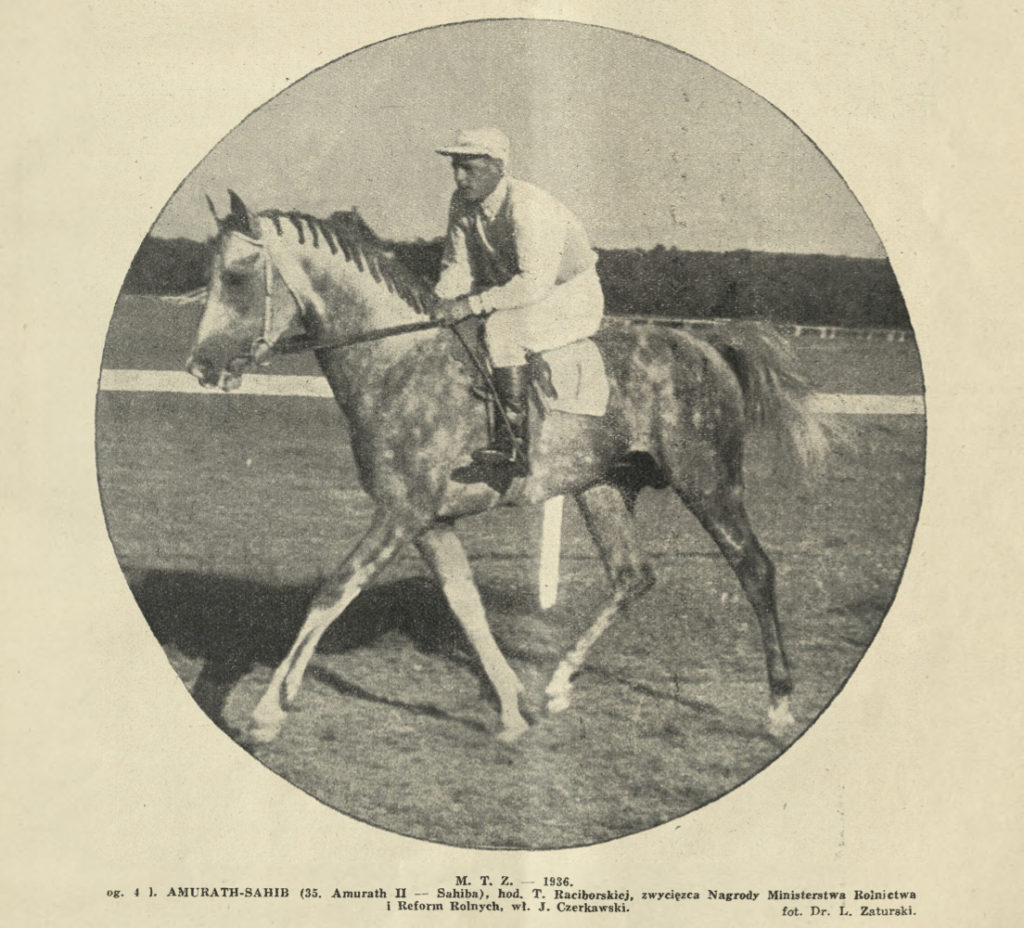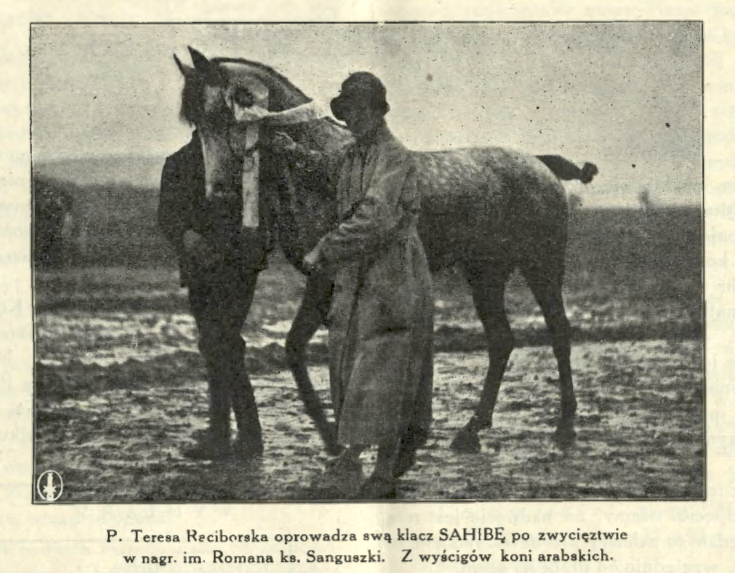Amurath Sahib and his dam Sahiba
Below is a photo of Amurath Sahib as a four-year-old, in racing condition. The picture comes from Jezdziec i Hodowca, Vol. 15 (36), 1936.

In addition to being a racehorse himself, Amurath Sahib sired the Polish Derby winner Equifor, and the Polish Oaks winners Estokada and Adis Abeba. He was also fortunate enough to escape the Dresden firebombing that decimated the stallions of Janów Podlaski, as he was the mount of Dr Andrzej Krzysztalowicz, who had stayed behind to watch over the mares while the stallions were sent on ahead.
None of his sons used for breeding – Arax, Equifor, and Gwarny – were asil, and only two of his daughters were, 25 Amurath Sahib, bred by Bábolna, and Arwila. While Amurath Sahib is still represented in pedigrees today, there is no asil descent left from him. [Edit: As R. J. Cadranell points out in the comments below, 25 Amurath Sahib still has asil descendants. Mea culpa.]
His dam, Sahiba, was herself a good racehorse, with victory in the Sanguszko Prize (over 2,400m) as a three-year-old. She also won both the Polish Oaks and the Polish Derby. Her sire, Nana Sahib, was a grandson of Amurath 1881 Weil, so that Amurath Sahib was inbred to this stallion through both his sire and his dam. Sahiba’s dam, Donka, was bred at Bábolna, and traces back in tail female to the desert-bred mare 39 Nedjme. However, what is quite striking, when looking at Sahiba’s pedigree, is how many desert-bred ancestors she has up close, as she goes back to the imported stallions Djerid, O’Bajan and Schechan Schammar, as well as the chestnut mare Smyrna, brought to Germany from Damascus, Syria.


Sahiba was a good broodmare, as she produced not just Amurath Sahib but also the 1935 Polish Derby winner Ibn Nedjari, by Roman Sanguszko’s French import Nedjari (Nibeh x Nedjarine). She was also the dam of two full siblings by Kuhailan Haifi, a colt, Sumak, and a daughter, Siniora. Siniora in her turn had two daughters of her own, Sahibka, by Polish Derby winner Kaszmir, and Signiorita, by Kuhailan Afas.
Sadly, the Breniów Stud of the Raciborskis was destroyed in WWII, and the horses lost, including Siniora and her two daughters, bringing an end to the asil female family descending from Sahiba.
Kate: Weren’t the few other Polish Asils sold off to the English who promptly bred them to Skowronek line Crabbet horses?
Also as far as I know isn’t there only one Babolna line Asil mare left too?
best
Bruce Peek
Bruce, yes, that certainly happened to some of the Polish asils; Amurath Sahib’s daughter Arwila was one of them, imported by Patricia Lindsay of Stockings Farm Stud in 1965, with her Czort daughter Arabija at her side. She produced nothing asil in Poland either, and in England was bred to stallions from Polish and Crabbet lines. Asil mares in Poland didn’t fare much better, either – Ferha, the granddaughter of Szeikha, Kuhailan Haifi and Kuhailan Zaid, was bred to non-asil stallions and left no asil offspring either.
I don’t know much about Bábolna, though – you’ll have to ask someone more knowledgeable than I am!
I thought that 25 Amurath Sahib was represented in modern asil stock from Babolna breeding? She had foals by Farag (namely 20 Farag and Farag II), Ghalion (namely Ghalion-6 a/k/a Amman), and the asil Babolna stallion Siglavy Bagdady VI (namely 3 Siglavy Bagdady VI), and those lines continued for several generations. Have they recently died out??
R. J., you are quite right! The 25 Amurath Sahib line still has living asil descent. This will teach me to make a post and not double-check Bábolna horses. Will make a note in the body of the post itself so as not to confuse anyone else!
Oh wow.. Good news! Any indication who owns them and if they’re breeding these days?
best
Bruce Peek
Perhaps I missed it somewhere, but what was this horse’s strain?
Since I believe Kate went to bed before she could answer this — Farag Arabians still breeds them. Edouard wrote about them about a decade ago: http://daughterofthewind.org/photo-of-the-day-farag-ii-32-in-germany/
Lyman, the tail female line goes back to 39 Nedjme, who I’m honestly having a hard time finding information on with a cursory search. RJ or Edouard might know more. I can check the source material where Kate got the photos for this post, as well, and see if maybe I can glean something from the text.
The strain of 39 Nedjmee is Kuhaylat Umm Urqub from Najd.